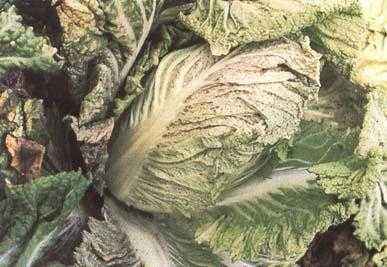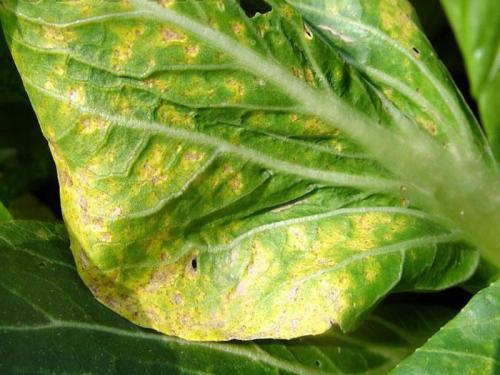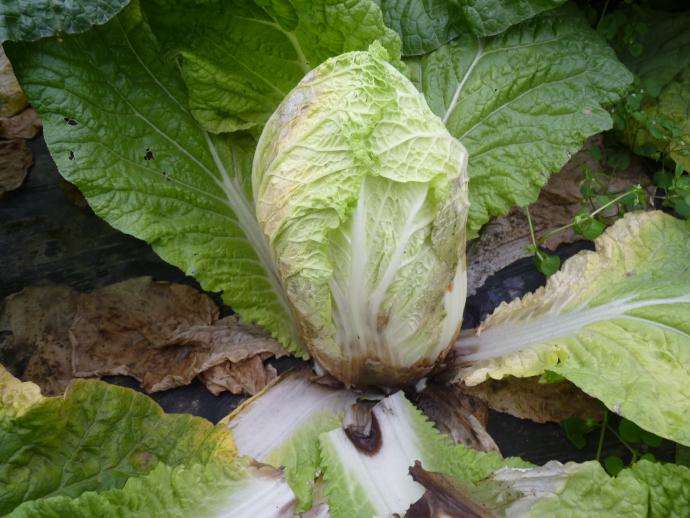In the process of Chinese cabbage production, viral diseases, downy mildew and soft rot are the three most common diseases, which affect the yield and reduce the quality of vegetables and seriously endanger their growth. The occurrence and prevention of several diseases are introduced as follows:
Viral disease

Viral diseases mainly occur in spring and autumn, especially in autumn, especially in high temperature and drought conditions; aphid activity tends to make the spread of the virus worse; weeds are also the initial source of virus transmission. There are various viruses that cause cabbage virus diseases, and mainly include turnip mosaic virus, cucumber mosaic virus, tobacco mosaic virus, and radish mosaic virus. Symptoms vary slightly depending on the type and variety of cabbage. However, the general symptoms are: the heart of the seedling stage is clear veins or veins are chlorotic, and then green uneven mottled or mosaic leaves are produced. In severe cases, the leaves are shrunk. In the adult stage, the leaves are severely shrunk, hard and brittle, and many brown spots are often found. The brown veins on the main back of the leaves are slightly browned and necrotic, and the plants are obviously dwarfed. After the onset of Chinese cabbage, no ball or loose ball is formed.
Control method. First, do a good job in seed processing. Seed poisoning is one of the main sources of vegetable virus disease. If the seed is poisonous, the crop will be infected with the disease at the seedling stage, which has a great impact on the yield. Therefore, we must pay attention to the seed treatment work. Soak seeds for 1-20 minutes with 1% potassium permanganate solution before sowing, or soak for 20-30 minutes with 10% trisodium phosphate solution to passivate the virus on the seeds. The second is pest control in the seedling stage. The virus is weakly invasive and can only invade the host through micro-wounds. It is often transmitted by insects such as aphids, planthoppers, and spider mites, so it is necessary to prevent and control the above insects in time. From the vegetable seedling stage, it is necessary to control aphids, planthoppers, etc. This is the most effective way to prevent viral diseases. The medicament may be selected from 10% imidacloprid wettable powder 2000-3000 times liquid, 2.5% kungfu emulsifiable concentrate 3000 times liquid, 10% dry net 1000 times liquid and the like. The third is to strengthen the management of field cultivation. Sowing at the right time, cultivating strong seedlings, promoting the growth of plants and improving the ability of plants to resist viral diseases. Remove the weeds in the field and remove the diseased plants to remove the poison. Care should be taken when performing farming operations in the field to reduce the formation of wounds. The fourth is chemical control. Commonly used agents are 20% virus A500 times solution, 20% bacteria gram gram 500 times solution, 5% bacteria toxic clear 300 times solution, 5% phytopathogenic 1000 times solution. If necessary, mix spray with the agent that controls the mites. Other plant growth regulators such as gibberellin and brassinolide have significant inhibitory effects on vegetable virus diseases and can be used in combination with the above agents.
Downy mildew

It mainly occurs in the "Lotus Period" of Chinese cabbage. When the leaves of each layer start lifting and involving, the most suitable disease condition is small temperature difference between day and night, continuous rain and rain, and soil waterlogging. In addition to harming Chinese cabbage, it can also harm vegetables such as vegetables, cabbage, mustard, cabbage, broccoli, etc., not only has a wide range of diseases, but also serious damage, mostly in early spring and late autumn, and can reduce production by more than 30% in a pandemic year.
Harmful symptoms. Mainly harmful to the leaves. At the seedling stage, the surface of the diseased leaves formed a pale green spot, which turned yellow. When wet, the surface of the leaf grows white mildew, forming a nearly rounded spot on the high temperature diseased part. In the adult stage, the lesions turn green or yellow. During the development process, they are restricted to polygons by the veins. When the conditions are appropriate, the condition develops rapidly, and the leaves die from the inside to the outside. The plant is damaged, the peduncle is deformed or swollen, and necrotic spots are formed on the flowers and pods. When the air is wet, the diseased part produces mildew. The disease is highly prone to and spread under warm and rainy conditions or poor drainage. In many areas, the seedling stage is infected with downy mildew, and the pathogens are transplanted into the field with the seedlings. The mid-to-late October is the peak period of disease epidemics. In order to ensure that Chinese cabbage is not lost, the prevention and treatment of diseases should be strengthened.
Control method. One is to select and process the seeds. Set up disease-free seeding or picking plants from healthy plants, and select them with 10% salt water before sowing, remove cockroaches and diseased seeds, wash the seeds with water, and mix 75% chlorothalonil according to the weight of dry seeds. Wet powder or 50% thiram double wettable powder can also be seeded with 25% metalaxyl WP, the dose is 0.3% of the seed weight. The second is to implement crop rotation and timely planting. Avoid continuous or adjacent crops with cruciferous vegetables, and it is best to rotate with field crops for 2-3 years. Reasonable close planting reduces the humidity in the field and alleviates the occurrence of various leaf spot and soft rot. The third is to implement rational fertilization and irrigation. Deep ploughing of the soil, applying the base fertilizer, adding phosphorus and potassium fertilizer in stages; performing foliar fertilization, spraying the production of bacteria, adding 75 liters per 30 ml of water; or spraying 6,000-9000 times of phytosanitary solution; rational irrigation, timely cultivating, timely attention Drainage, promote plant root growth and enhance disease resistance. The fourth is to implement chemical control. In the early stage of the field, or in combination with the weather forecast, timely drug control. Foliar application can be selected from the following agents: 58% metalaxyl Mn-Zn wettable powder 500 times solution, 75% chlorothalonil WP 600 times solution, 60% anti-bacterial WP WP 500 times solution 72.2% Plex water agent 600-800 times liquid and so on. Spray once every 7-10 days, even spray 2-3 times, and spray with rain. In the mixed area with leukoplakia, it can be sprayed with 25% carbendazim WP 400 times in the aluminum triethylphosphinate solution; and 50% of the phorhin WP can be added in the same period as the black spot. Liquid spray.
Soft rot

Soft rot usually occurs in the middle and late stages of the core ball, and is a bacterial disease. When there is water in the soil and too much rain when starting the heart, the insects are easy to be ill when the damage is serious, and the expansion is fast. Once the infection is severely damaged, the light loss is 30%-40%, the heavy loss is 60%-70%, and even the harvest is One of the more difficult diseases of vegetable farmers.
Harmful symptoms. It began to show water-stained plaques near the roots of the leaves, which quickly became mushy and turned brown with a stench; sometimes it expanded from the heart to the outer leaves, and the leaves edged to the leaves and dried and burned, usually seen from It takes only about 5 days for the lesion to decay, and it develops rapidly. There are three common types: the outer leaves are wilting, and the rosettes are wilted at noon on sunny days, recovering sooner or later, the tissues of the petioles or rhizomes are festered, and the sapphire viscous material flows out. The bacteria invade from the roots of the vegetable roots to form water. The area is light gray-brown, and the tissue of the diseased part is sticky and soft rot; the pathogen is invaded by the edge of the petiole or the outer leaf, or the top of the leaf ball, causing rot, and there is a foul smell in the diseased area, which is important for soft rot. Characteristics can be distinguished from Chinese cabbage black rot. The disease is poorly drained, flooded or serially irrigated in continuous cropping and low-lying areas. When unfertilized compost is applied, the incidence is fast and heavy.
Control method. In order to prevent and control Chinese cabbage soft rot, comprehensive control measures must be taken to receive good results. Agricultural control. First, the selection of resistant varieties, the general green varieties are more resistant to disease. The second is to strengthen the cultivation management, change the planting of ridges for ridges, avoid plant immersion in the water after rainfall; transplant seedlings for live broadcast, reduce wounds; apply more decomposed organic fertilizer and phosphorus and potassium fertilizer to breed strong seedlings. Do not flood the water, and drain the water in time to reduce the humidity in the field. The third is to implement crop rotation. The seriously ill plot should be rotated with gramineous crops or onions and garlic vegetables to avoid rotation with Solanaceae, melons and other cruciferous vegetables. The fourth is to timely control the insects. Before planting or at the seedling stage, use phoxim, chlorpyrifos and other pesticides to mix the soil or apply it, or use 90% crystal trichlorfon 800-1000 times to grout the roots to prevent underground pests such as golden worms, cockroaches and cockroaches. The avermectin and other agents control leaf-eating pests such as cabbage caterpillar, beet armyworm, and diamondback moth. After cabbage is infected with soft rot, it is difficult to cure once it shows symptoms. When a sporadic diseased plant is found in the field, it should be immediately removed with root soil and taken out of the field for deep burial, and lime-disinfected to seal the diseased hole, and then sprayed on the whole field.
Chemical control. To prevent and control Chinese cabbage soft rot, it is necessary to spray 72% agricultural streptomycin sulfate soluble powder 3000-4000 times liquid, or neomycin oxytocin 3000-4000 times liquid, or agricultural anti-751 water agent 200 times liquid. Spray once every 10 days, even spray 3-4 times. You can also use 70% dikesone wettable powder 800-1000 times liquid to fill the roots, each plant is filled with 500 ml of diluted liquid, and then refilled once every 7-10 days, even spray 2-3 times, or use 50% Dyson The ammonium water agent is sprayed 1000 times, so that the spray irrigation can be combined. Each of the above-mentioned medicaments has a good preventive effect before and during the onset of soft rot of Chinese cabbage, and the control effect after the onset of the disease is significantly reduced. According to relevant research reports, Kecocon (3% zhongshengmycin wettable powder), thidium copper and other agents have better control effects on Chinese cabbage soft rot than agricultural streptomycin and dexamethasone. The earlier the medication, the better the disease prevention effect. According to the test, the seedlings were mixed with the gramogen and sprayed at the seedling stage and the rosette stage, and the control effect was over 90%. However, the use of the chlorpyrifos seed dressing or spraying in the rosette and the core period significantly reduced the control effect. When spraying, you can add 10-20 mg / kg of "increased production", or 0.5% urea or 1000 times of potassium dihydrogen phosphate mixed spray to promote the core.
Dimming film is suitable for use in dry environment, personnel stable places, such as offices, personal residence, etc., are a good choice of application. Smart glass can be used for indoor or outdoor glass applications. Switches from opaque (white) to transparent in less than a second.
There is no need to customize dimming glass, only need to paste dimming film on the original bullet-proof glass, you can realize the mutual switch of glass transparency and atomization effect.
The transparecy of the intelligent glass film decreases with the decrease of voltage until the closed state is the complete atomization state.
After receiving the report, our after-sales service personnel will arrange technical personnel to solve the problem immediately.
You can also contact us for product use, maintenance and other related issues through our website. It is pur pleasure for you to make reasonable suggestions or comments on our products.
In short, with the continuous development of technology, smart dimming glass is getting closer and closer to the explosion. I believe that with the gradual recognition of the market and the continuous advancement of technology, this product will bring more convenience to our lives and make our lives better.
Office Decoration Smart Glass,Office Intelligent Glass,Office Tinted Glass,Electric Smart Glass Office Decoration,Office Decoration Glass Door,Privacy Glass For Meeting Room
Tianqixun Technology , https://www.tqxdisplay.com